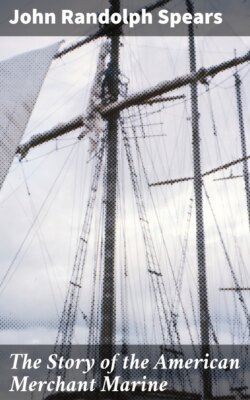The Story of the American Merchant Marine

Реклама. ООО «ЛитРес», ИНН: 7719571260.
Оглавление
John Randolph Spears. The Story of the American Merchant Marine
The Story of the American Merchant Marine
Table of Contents
ILLUSTRATIONS
CHAPTER I. IN THE BEGINNING
CHAPTER II. EARLY GROWTH
CHAPTER III. EVOLUTION OF THE SMUGGLER AND THE PIRATE
CHAPTER IV. BEFORE THE WAR OF THE REVOLUTION
CHAPTER V. MERCHANTMEN IN BATTLE ARRAY
CHAPTER VI. EARLY ENTERPRISE OF THE UNITED STATES MERCHANT MARINE
CHAPTER VII. FRENCH AND OTHER SPOLIATIONS
CHAPTER VIII. THE BRITISH AGGRESSIONS
CHAPTER IX. THE BEGINNINGS OF STEAM NAVIGATION
CHAPTER X. PRIVATEERS, PIRATES, AND SLAVERS OF THE NINETEENTH CENTURY
CHAPTER XI. THE HARVEST OF THE SEA BEFORE THE CIVIL WAR
CHAPTER XII. THE PACKET LINES AND THE CLIPPERS
CHAPTER XIII. DEEP-WATER STEAMSHIPS—PART I
CHAPTER XIV. DEEP-WATER STEAMSHIPS—PART II
CHAPTER XV. THE CRITICAL PERIOD
CHAPTER XVI. DURING A HALF CENTURY OF DEPRESSION
Отрывок из книги
John Randolph Spears
Published by Good Press, 2019
.....
Winthrop's Blessing of the Bay appears to have been the first New England vessel to open trade with the Dutch on Manhattan Island. She went there in 1633, perhaps sooner. In 1627 the Dutch had invited "friendly commercial relations" with the Pilgrims by sending the governor of the colony "a rundlet of sugar and two Holland Cheeses," with a letter in which they offered to "accommodate"—to give credit. But the Pilgrims were shy because the Dutch had been trading with the Connecticut Indians, a region claimed by the English; the Dutch had come even to the head of Buzzard's Bay, where the Pilgrims were maintaining a post for the fur trade. However, in September, 1627, the Dutch sent Isaac de Rasieres with a small trial cargo in the "barque Nassau" to see what he could do, and he proved a worthy forerunner of the great race of American commercial travellers. For he carried soldiers and trumpeters along, not to fight, but to do honor to the occasion by means of salutes and blaring music; and he chose these men from among the residents of New Amsterdam who had known some of the Pilgrims in Holland. Indeed, some of them were related to the Pilgrims. Naturally, after "the joyful meeting of kindred as well as friends," and after much fine talk and the display of goods—especially of "wampum,"—De Rasieres made what he called "the beginning of a profitable trade."
Wampum (bits of sea-shell) was the coin of the red men. The chief mint of the continent was on Long Island. All red men, at that time, were much more anxious to get wampum than the silver coin of the white man. The Pilgrims were glad to buy the wampum because the Indians of New England had but little, and were eager to get it.
.....